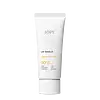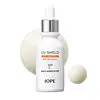What's inside
What's inside
 Key Ingredients
Key Ingredients

 Benefits
Benefits

 Concerns
Concerns

 Ingredients Side-by-side
Ingredients Side-by-side

Water
Skin ConditioningButylene Glycol
HumectantEthylhexyl Methoxycinnamate
UV AbsorberC12-15 Alkyl Benzoate
AntimicrobialBis-Ethylhexyloxyphenol Methoxyphenyl Triazine
Skin ConditioningDiethylamino Hydroxybenzoyl Hexyl Benzoate
UV FilterTitanium Dioxide
Cosmetic ColorantCyclopentasiloxane
EmollientNiacinamide
SmoothingDimethicone
EmollientSilica
AbrasiveCyclohexasiloxane
EmollientCetyl Alcohol
EmollientGlyceryl Stearate
EmollientPEG-100 Stearate
Trisiloxane
Skin ConditioningNylon-12
C14-22 Alcohols
Emulsion StabilisingPolyacrylate-13
Aluminum Stearate
Cosmetic ColorantParfum
MaskingPolyhydroxystearic Acid
EmulsifyingPolyisobutene
Alumina
AbrasiveStearic Acid
CleansingTocopheryl Acetate
AntioxidantC12-20 Alkyl Glucoside
EmulsifyingPolysilicone-11
C12-15 Alcohols
EmollientMethoxy PEG-114/Polyepsilon Caprolactone
BufferingGlyceryl Caprylate
EmollientBifida Ferment Lysate
Skin ConditioningCarbomer
Emulsion StabilisingCichorium Intybus Root Extract
MaskingEthylhexylglycerin
Skin ConditioningDisodium EDTA
Polysorbate 20
EmulsifyingAdenosine
Skin ConditioningSorbitan Isostearate
EmulsifyingPhenoxyethanol
PreservativeGossypium Herbaceum Extract
Skin ConditioningGlucose
HumectantSodium Benzoate
MaskingAcetic Acid
BufferingLactic Acid
BufferingTocopherol
AntioxidantWater, Butylene Glycol, Ethylhexyl Methoxycinnamate, C12-15 Alkyl Benzoate, Bis-Ethylhexyloxyphenol Methoxyphenyl Triazine, Diethylamino Hydroxybenzoyl Hexyl Benzoate, Titanium Dioxide, Cyclopentasiloxane, Niacinamide, Dimethicone, Silica, Cyclohexasiloxane, Cetyl Alcohol, Glyceryl Stearate, PEG-100 Stearate, Trisiloxane, Nylon-12, C14-22 Alcohols, Polyacrylate-13, Aluminum Stearate, Parfum, Polyhydroxystearic Acid, Polyisobutene, Alumina, Stearic Acid, Tocopheryl Acetate, C12-20 Alkyl Glucoside, Polysilicone-11, C12-15 Alcohols, Methoxy PEG-114/Polyepsilon Caprolactone, Glyceryl Caprylate, Bifida Ferment Lysate, Carbomer, Cichorium Intybus Root Extract, Ethylhexylglycerin, Disodium EDTA, Polysorbate 20, Adenosine, Sorbitan Isostearate, Phenoxyethanol, Gossypium Herbaceum Extract, Glucose, Sodium Benzoate, Acetic Acid, Lactic Acid, Tocopherol
Water
Skin ConditioningDibutyl Adipate
EmollientGlycerin
HumectantBis-Ethylhexyloxyphenol Methoxyphenyl Triazine
Skin ConditioningEthylhexyl Salicylate
UV AbsorberDrometrizole Trisiloxane
UV AbsorberTerephthalylidene Dicamphor Sulfonic Acid
UV AbsorberHomosalate
Skin ConditioningNiacinamide
SmoothingPolysilicone-15
UV Filter1,2-Hexanediol
Skin ConditioningTromethamine
BufferingBehenyl Alcohol
EmollientGlyceryl Stearate Se
EmulsifyingSodium Polyacryloyldimethyl Taurate
Emulsion StabilisingPhenyl Trimethicone
Skin ConditioningPotassium Cetyl Phosphate
EmulsifyingCaprylyl Methicone
Skin ConditioningPropanediol
SolventAllantoin
Skin ConditioningParfum
MaskingPolyacrylate Crosspolymer-6
Emulsion StabilisingCaprylyl Glycol
EmollientEthylhexylglycerin
Skin ConditioningMannitol
HumectantPolyacrylate-13
Adenosine
Skin ConditioningHydrogenated Polyisobutene
EmollientLimonene
PerfumingLinalool
PerfumingPolyglyceryl-10 Laurate
Skin ConditioningCitronellol
PerfumingEthylhexyl Palmitate
EmollientSorbitan Isostearate
EmulsifyingAllium Cepa Bulb Extract
Skin ConditioningAcetyl Tetrapeptide-11
Skin ConditioningTocopherol
AntioxidantWater, Dibutyl Adipate, Glycerin, Bis-Ethylhexyloxyphenol Methoxyphenyl Triazine, Ethylhexyl Salicylate, Drometrizole Trisiloxane, Terephthalylidene Dicamphor Sulfonic Acid, Homosalate, Niacinamide, Polysilicone-15, 1,2-Hexanediol, Tromethamine, Behenyl Alcohol, Glyceryl Stearate Se, Sodium Polyacryloyldimethyl Taurate, Phenyl Trimethicone, Potassium Cetyl Phosphate, Caprylyl Methicone, Propanediol, Allantoin, Parfum, Polyacrylate Crosspolymer-6, Caprylyl Glycol, Ethylhexylglycerin, Mannitol, Polyacrylate-13, Adenosine, Hydrogenated Polyisobutene, Limonene, Linalool, Polyglyceryl-10 Laurate, Citronellol, Ethylhexyl Palmitate, Sorbitan Isostearate, Allium Cepa Bulb Extract, Acetyl Tetrapeptide-11, Tocopherol
Ingredients Explained
These ingredients are found in both products.
Ingredients higher up in an ingredient list are typically present in a larger amount.
Adenosine is in every living organism. It is one of four components in nucleic acids that helps store our DNA.
Adenosine has many benefits when used. These benefits include hydrating the skin, smoothing skin, and reducing wrinkles. Once applied, adenosine increases collagen production. It also helps with improving firmness and tissue repair.
Studies have found adenosine may also help with wound healing.
In skincare products, Adenosine is usually derived from yeast.
Learn more about AdenosineYou might know this ingredient as Tinosorb S or Bemotrizinol. It is a UV filter that covers both UVA and UVB rays.
This ingredient has two peak UV absorption peaks ( 310 and 340 nm) and is able to absorb both UV-A and UV-B rays. This ingredient works by preventing UV rays from reaching and damaging your skin.
On top of that - it is highly photostable and helps prevent the photodegration of other sunscreen ingredients such as avobenzone.
Tinosorb S is allowed in the EU, Australia, and Asia. It is close to being approved by the FDA and we'll hopefully get this ingredient in the U.S. by late 2025.
Fun fact: Tinosorb S is the most effective UV absorber at maximum concentration (measured by SPF) permitted in the EU.
This ingredient is oil-soluble, so your oil-cleansers will take this right off at night.
Learn more about Bis-Ethylhexyloxyphenol Methoxyphenyl TriazineEthylhexylglycerin (we can't pronounce this either) is commonly used as a preservative and skin softener. It is derived from glyceryl.
You might see Ethylhexylglycerin often paired with other preservatives such as phenoxyethanol. Ethylhexylglycerin has been found to increase the effectiveness of these other preservatives.
Niacinamide is a multitasking form of vitamin B3 that strengthens the skin barrier, reduces pores and dark spots, regulates oil, and improves signs of aging.
And the best part? It's gentle and well-tolerated by most skin types, including sensitive and reactive skin.
You might have heard of "niacin flush", or the reddening of skin that causes itchiness. Niacinamide has not been found to cause this.
In very rare cases, some individuals may not be able to tolerate niacinamide at all or experience an allergic reaction to it.
If you are experiencing flaking, irritation, and dryness with this ingredient, be sure to double check all your products as this ingredient can be found in all categories of skincare.
When incorporating niacinamide into your routine, look out for concentration amounts. Typically, 5% niacinamide provides benefits such as fading dark spots. However, if you have sensitive skin, it is better to begin with a smaller concentration.
When you apply niacinamide to your skin, your body converts it into nicotinamide adenine dinucleotide (NAD). NAD is an essential coenzyme that is already found in your cells as "fuel" and powers countless biological processes.
In your skin, NAD helps repair cell damage, produce new healthy cells, support collagen production, strengthen the skin barrier, and fight environmental stressors (like UV and pollution).
Our natural NAD levels start to decline with age, leading to slower skin repair, visible aging, and a weaker skin barrier. By providing your skin niacinamide, you're recharging your skin's NAD levels. This leads to stronger, healthier, and younger looking skin.
Another name for vitamin B3 is nicotinamide. This vitamin is water-soluble and our bodies don't store it. We obtain Vitamin B3 from either food or skincare. Meat, fish, wheat, yeast, and leafy greens contain vitamin B3.
The type of niacinamide used in skincare is synthetically created.
Learn more about NiacinamideParfum is a catch-all term for an ingredient or more that is used to give a scent to products.
Also called "fragrance", this ingredient can be a blend of hundreds of chemicals or plant oils. This means every product with "fragrance" or "parfum" in the ingredients list is a different mixture.
For instance, Habanolide is a proprietary trade name for a specific aroma chemical. When used as a fragrance ingredient in cosmetics, most aroma chemicals fall under the broad labeling category of “FRAGRANCE” or “PARFUM” according to EU and US regulations.
The term 'parfum' or 'fragrance' is not regulated in many countries. In many cases, it is up to the brand to define this term.
For instance, many brands choose to label themselves as "fragrance-free" because they are not using synthetic fragrances. However, their products may still contain ingredients such as essential oils that are considered a fragrance by INCI standards.
One example is Calendula flower extract. Calendula is an essential oil that still imparts a scent or 'fragrance'.
Depending on the blend, the ingredients in the mixture can cause allergies and sensitivities on the skin. Some ingredients that are known EU allergens include linalool and citronellol.
Parfum can also be used to mask or cover an unpleasant scent.
The bottom line is: not all fragrances/parfum/ingredients are created equally. If you are worried about fragrances, we recommend taking a closer look at an ingredient. And of course, we always recommend speaking with a professional.
Learn more about ParfumPolyacrylate-13 is a type of acrylate polymer. Acrylate polymers are commonly used as adhesives in cosmetics.
Polyacrylate-13 creates a film to protect the skin. It is also used to thicken and stabilize a product. It works by making water a gel-like consistency. This gel consistency helps suspend particles.
Polyacrylate-13 is a copolymer of acrylic acid, acrylamide, sodium acrylate, sodium acryloyldimethyltaurate monomers
Learn more about Polyacrylate-13Sorbitan Isostearate is an emulsifer and cleaning agent. It is created from isostearic acid and sorbitol.
As an emulsifier, Sorbitan Isostearate prevents oils and water from separating.
Due to its isostearic acid base, it may not be safe for Malassezia or fungal acne.
Learn more about Sorbitan IsostearateTocopherol (also known as Vitamin E) is a common antioxidant used to help protect the skin from free-radicals and strengthen the skin barrier. It's also fat soluble - this means our skin is great at absorbing it.
Vitamin E also helps keep your natural skin lipids healthy. Your lipid skin barrier naturally consists of lipids, ceramides, and fatty acids. Vitamin E offers extra protection for your skin’s lipid barrier, keeping your skin healthy and nourished.
Another benefit is a bit of UV protection. Vitamin E helps reduce the damage caused by UVB rays. (It should not replace your sunscreen). Combining it with Vitamin C can decrease sunburned cells and hyperpigmentation after UV exposure.
You might have noticed Vitamin E + C often paired together. This is because it is great at stabilizing Vitamin C. Using the two together helps increase the effectiveness of both ingredients.
There are often claims that Vitamin E can reduce/prevent scarring, but these claims haven't been confirmed by scientific research.
Learn more about TocopherolWater. It's the most common cosmetic ingredient of all. You'll usually see it at the top of ingredient lists, meaning that it makes up the largest part of the product.
So why is it so popular? Water most often acts as a solvent - this means that it helps dissolve other ingredients into the formulation.
You'll also recognize water as that liquid we all need to stay alive. If you see this, drink a glass of water. Stay hydrated!
Learn more about Water